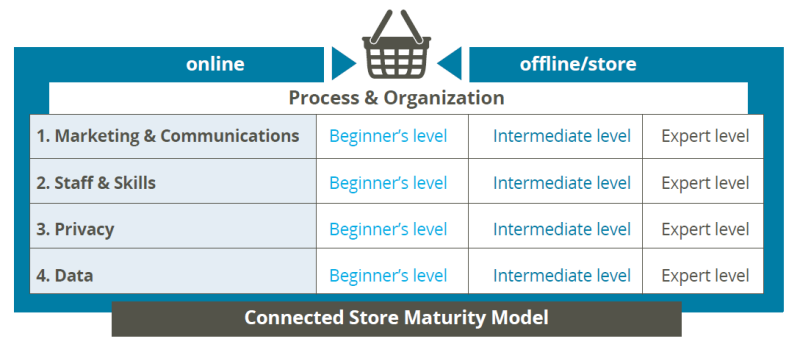Moving towards the ultimate connected store
What should you do in order to make the customer feel connected with you, the retailer? The ShoppingTomorrow expert group Connected Stores has developed a model that can identify which transformation steps you need to move through, in key areas, to ultimately achieve the ideal of a connected store. It is a store that recognises the instore customer and helps them with their purchase, using personalised and relevant advice. The procedure and the organisation are at the foundation, but are also fundamental in their support and direction of the four axes, which are: marketing & communication, staff & skills, privacy and data.

Procedure and organisation
An optimum customer experience is based on an organisation that is working as it should. When designing the organisation and its procedures, the customer needs to be the main focus. The retailer is able to describe a process of growth towards maturity, based on one or more customer journeys, and on the required activities and roles within the company. This process of growth ought to bring substance to the skills and responsibilities involved in the various roles within the organisation, and to the interaction and cooperation between those roles. Optimising this process is an ongoing operation, in which it is essential to enhance skills/expertise, efficiency and precision.

Marketing and communication
Marketing and communication are on the first axis of the model. There are three criteria to measure which degree of maturity an organisation has, in relation to marketing and communication:
- The customer
- Data model
- (Predictive) marketing
Staff and skills
How can staff members be measured according to the levels of beginner, intermediate or expert, in relation to staff and skills? The expert group has defined five criteria to delve into the role of staff members and their required skills:
- Product expertise
- Social skills
- Technological skills
- Mandate
- After-sales service
Privacy
A key aspect of the connected store is customer recognition, in other words: the processing of personal data. Customers will be given a choice as to whom they share their data with, and over which period of time. More than they currently do, customers will be able to decide to share data in exchange for goods and services. Virtual assistants will keep the customer ‘awake’ and send regular updates as to who has access to their data. There will be a real-time understanding of the data and what is being done with it. For retailers, this translates into having to ‘purchase’ the key information from their customers, by providing relevant goods and services. The retailer will continue to have access to anonymised data.
We can expect it to become easier for customers to obtain a summary of the data they have shared. Effortlessly managing the data will be possible too. Ultimately, a portal (app or website) could be the perfect way to have a complete overview of all the parties and permissions involved in data.
Data
Retailers will have instore methods and triggers that – partly thanks to the relevant data being available – can recognise existing customers and persuade new ones to registering as a customer. This is how the physical store is connected to the online one, and vice versa: a connected store.
The key success factor is how a retailer can entice a customer to (allow themselves to) be ‘known’ in the physical store. An important part of the solution is in which way retailers offer actual advantages to customers when they register and agree to being recognised.
Conclusion
The expert group, led by Capgemini and Centric, is keen to offer readers an understanding of the many aspects that affect which level of maturity your organisation is at, on its way to becoming a connected store. They would like to emphasise the need for organisations to make decisions based on which axes the organisation wishes to excel at, and which ones they are happy to be just ‘on par’. It would be utopian to draw a line towards the point in the distant future where all four axes are at expert level and expect to achieve that expertise overnight. Would you like to learn more? Download the blue paper by this expert group.